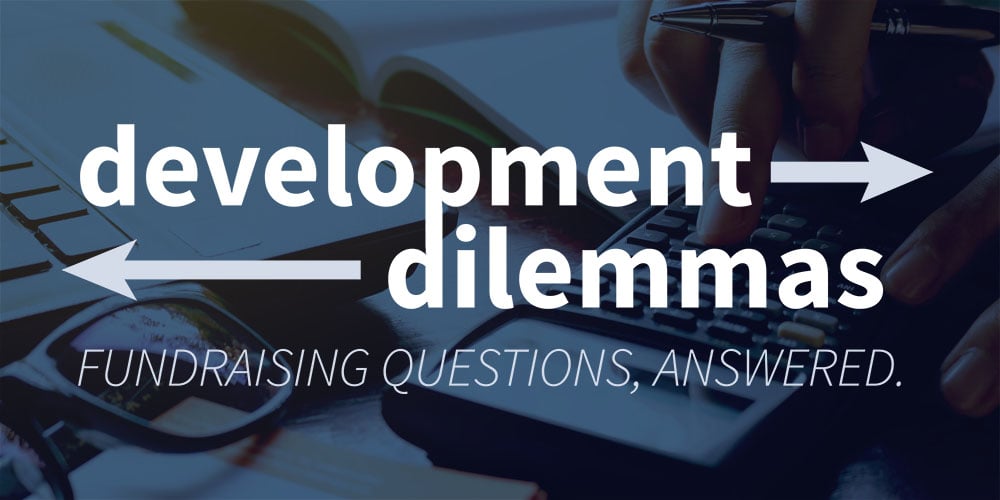How Much Should Nonprofits Spend on Fundraising?

In our weekly column, consultants with decades of nonprofit experience answer your questions about fundraising, boards, strategy and more. To ask a question and be featured (anonymously!) in the column, email your questions to info@twbfundraising.com.
This week’s question will be answered by Marilyn Foster Kirk.
The Dilemma
I’ve heard the phrase “you’ve got to spend money to raise money,” but I’ve also heard my Board wondering if we’re spending too much. As the chief development officer, how can I provide thoughtful leadership on this topic?
Marilyn's Response
Answering the question of how much money to spend on fundraising isn’t easy. There are lots of opinions about how much should be spent, and there are perceptions that fundraising is a cost rather than an investment. When you right down to it, determining how much is the right amount is complicated.
First, you may need to challenge some strongly held opinions among your Board members. There is a persistent idea that return on investment (ROI) and cost to raise a dollar (CTRD) ratios provide the answers. These ratios are easy to calculate but they really don’t answer the most important question which is “specifically for our organization, how much should we be spending on fundraising.”
Further, academic research shows us that many variables affect these ratios. These variables include organizational size, characteristics of an organization’s donors, the maturity of donor-organization relationships, fundraising expertise, fundraising methods, and the motivational appeal of organizational mission. Consequently, each organization has a distinctive profile of factors that influence cost-to-contribution comparisons, and comparing ratios to a standard really isn’t very useful.
There’s also the notion of fundraising as a cost. In this case, the concept of “cost” assumes the organization is spending money on fundraising rather than on something more central to its mission. Hence, the conclusion that we should spend as little as possible on fundraising. But, frankly, this is short-term thinking.
Encourage your Board to think strategically about building your organization’s capacity to attract more contributions not just next year but for years to come. Spending on fundraising should be a strategy to maximize contributed revenue over time. Wisely investing now leads to higher net returns in the future.
But if we want to achieve these longer-term returns, how do we determine how much to invest along the way? First, we need a donor behavior model that helps us understand something about giving progression. We have one we can use which is based on the observations of donors’ giving behaviors toward colleges and universities. This research-based model shows most new donors begin giving small gifts, usually under $100. Then, if donors are motivated to give consistently, we increase the likelihood that in seven years they will make a much larger gift--$1,000 in the model cited above. Within 12 more years, if we nurture donor relationships and donors upgrade their annual giving, we increase the probability of receiving very large commitments from some donors.
This model provides a road map for observing donors’ behaviors, and we can apply it to our specific circumstances to analyze productivity and investment strategies. Using our data, we can determine, on average, how long it takes for a newly acquired donor to reach a specific annual giving threshold such as the $1,000 gift in the model above. And we can determine how many first-time donors give consistently within the timeframe between first gift and reaching the threshold. If our donor retention rates and retained giving rates are low and if the timeframe from first gift to the threshold is quite long, we are likely not investing enough. In response, we need to implement actions to improve the probability of desired donor behavior and calculate the necessary budget support. On the other hand, if our donor behavior patterns parallel the model, we can probably assume our investment is about right.
We can also look at how long it takes an average donor to move from the annual giving threshold to an ultimate gift. We can also analyze whether donors are upgrading their gifts along the way. If the time span is quite long and if gifts are not regularly increasing in size, we may not be investing enough in these relationships. Then we can take actions to upgrade giving and reduce the time from threshold to largest lifetime gift.
Once you implement new strategies such as improving retention rates or strengthening upgrade rates, you need to compare fundraising costs to results for each activity over time, watching for changes in the ROI.
So, as we said earlier, there is no easy answer—no one formula to follow—that will tell you and your Board how much money it will take to raise the amount of money you need. And it takes time and persistence to effect change in donor behavior and to assess whether or not your investment is paying off. Remember, though, research confirms that the greater the investment, the greater the return.

Comments
Questions or comments? Join the conversation!